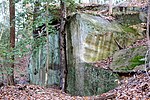Aquia Creek
Rivers of Fauquier County, VirginiaRivers of Stafford County, VirginiaRivers of VirginiaTributaries of the Potomac River

Aquia Creek ( ) is a 27.6-mile-long (44.4 km) tributary of the tidal segment of the Potomac River and is located in Northern Virginia. The creek's headwaters lie in southeastern Fauquier County, and it empties into the Potomac at Brent Point in Stafford County, 45 miles (72 km) south of Washington, D.C. The White House was built largely using sandstone quarried from Aquia Creek from 1792 to 1799.
Excerpt from the Wikipedia article Aquia Creek (License: CC BY-SA 3.0, Authors, Images).Aquia Creek
Hope Road,
Geographical coordinates (GPS) Address Nearby Places Show on map
Geographical coordinates (GPS)
| Latitude | Longitude |
|---|---|
| N 38.418305555556 ° | E -77.359055555556 ° |
Address
Hope Road
22554
Virginia, United States
Open on Google Maps






